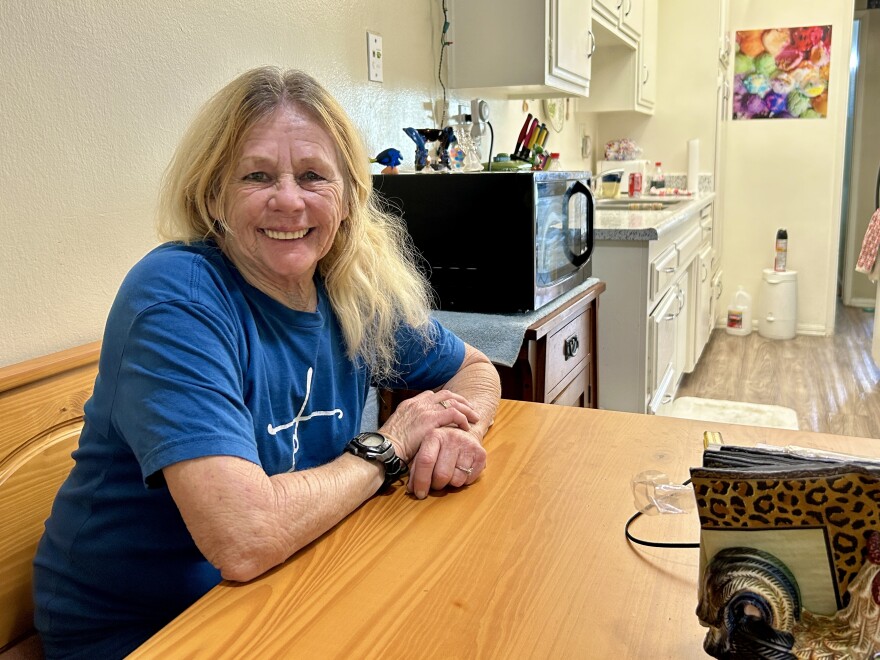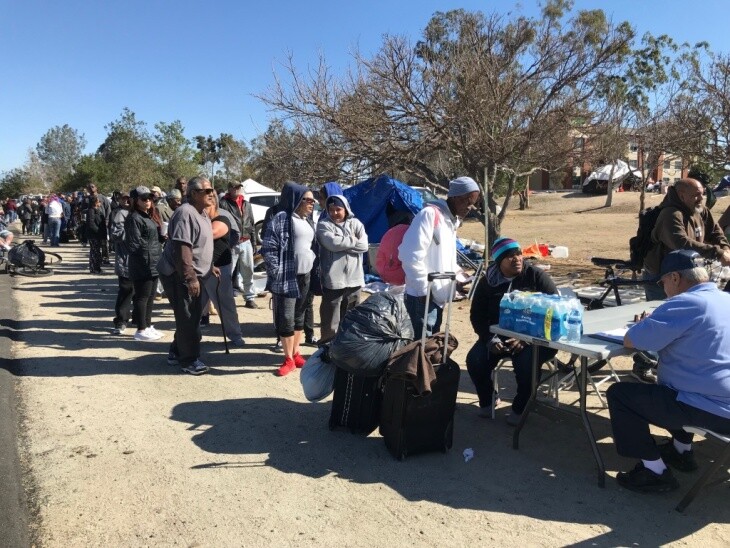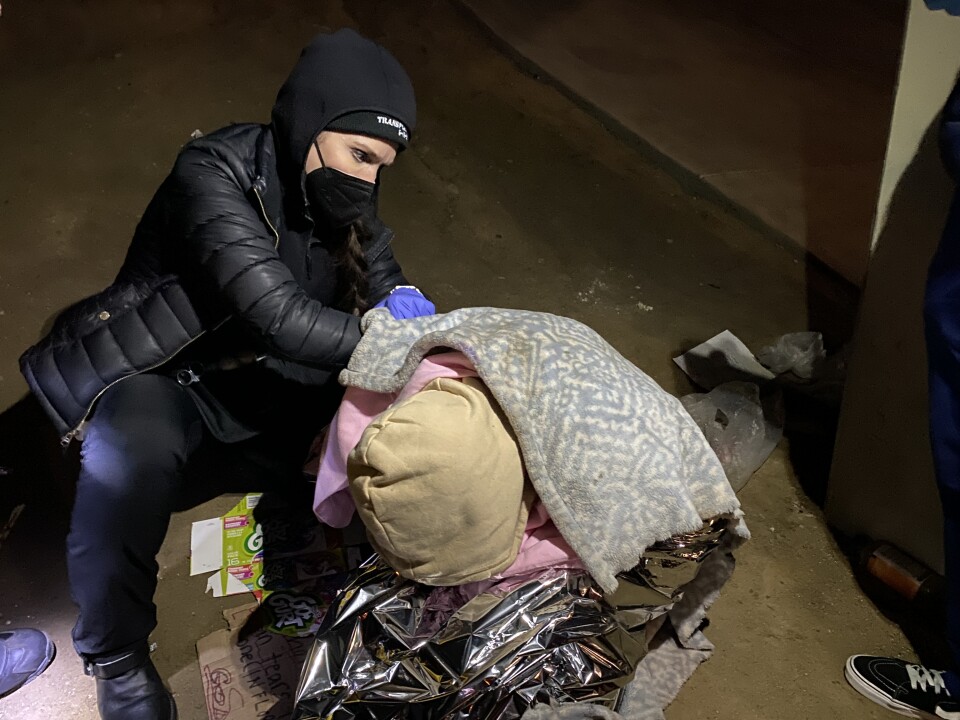This story is free to read because readers choose to support LAist. If you find value in independent local reporting, make a donation to power our newsroom today.
Can We Sue Our Way Out Of The Homelessness Crisis? What We've Learned From Orange County

In 2019, Orange County settled a years-long legal battle that marked a turning point in the way the county addresses homelessness. In the years since, there has been significant progress on the number of shelter beds and standards of care at those shelters. But those signs of progress are accompanied by more troubling indicators.
The shift started in 2017 when county officials sought to clear out a large homeless encampment that had become a health hazard and an embarrassment for public officials. Advocates for people experiencing homelessness sued, arguing that because of a dearth of shelter beds — and appropriate beds for people with disabilities — there was no place that people experiencing homelessness could sleep without violating the law.
The result: What's come to be known as the Catholic Worker settlement (Orange County Catholic Worker was one of the plaintiffs), which is actually a group of similar settlements involving more than a dozen O.C. cities.
Four years later:
- People sleeping on public property have to be assessed by outreach workers and offered appropriate shelter before law enforcement can enforce anti-camping rules.
- There are more emergency shelter beds. But often with more restrictions on who can use them.
- Shelters have to adhere to standards of care and there's an appeal process when disputes arise.
- There's more permanent supportive housing. But not nearly enough to meet demand.
- Federal emergency housing vouchers have helped fill the need for affordable housing. They expire in 2030.
- There are no longer massive encampments in places like the Santa Ana riverbed. But there are still more than 3,000 people without shelter on any given night, many of them in encampments that are more hidden and, advocates say, likely more dangerous.
- The number of unhoused people dying annually in Orange County has more than doubled in the last five years — to some 500 people last year.
The pre-pandemic lawsuits that led to many of these changes are similar to ones currently playing out in Los Angeles. LAist talked to officials, lawyers, homeless service providers, and people experiencing homelessness in Orange County about what's unfolded over the past several years.
From riverbed encampment to permanent housing: One woman's long journey
Kathy Schuler was living in a tent next to the Santa Ana River channel in central Orange County when I met her in early 2017. Eventually, an estimated 800 to 1,500 people ended up in the sprawling encampment, including Schuler's adult son and daughter.
It stretched for about two miles behind Angel Stadium and the Honda Center. Advocates sued each time county officials tried to clear the encampment.
[Read: The Court Case That Forced OC To Stop Ignoring Its Homeless]
During a survey of the encampment in April 2017 with Judge David Carter — the same federal judge who oversees several big cases on homelessness in L.A. — Schuler showed off the homey details of her tent, including a framed photograph of her with her kids and their bevy of dogs. The area in front of Schuler's tent was neatly swept and decorated with potted plants.

The following year, in February 2018, Schuler and everyone else in the encampment were told they had to leave. The county promised motel vouchers and help finding permanent housing as part of a deal between advocates and county officials brokered under Judge Carter's watch.

On a sunny February morning, Schuler and her encampment neighbors packed up their things and waited for buses to take them to their assigned bed.
Six years later …
I visited Schuler, now 66, and her dog Freeway this spring in their one-bedroom apartment in Tustin, where they've lived since 2021. The apartment is in a breezy, well-kept complex.
Schuler's walls are covered with jigsaw puzzles she's finished and mounted. Her patio is filled with plants, including a few she's been caring for since her time at the riverbed encampment.

What she likes most about her apartment: "Mine," she giggled, a smile spreading across her face. "Mine."
But it took Schuler more than three years of shuffling through motels and shelters to get her apartment, and only with a lot of help from advocates.
"How long is it gonna take?" Schuler remembers thinking on many occasions. "I'm glad I had people helping me out that know what's going on, you know," she said. "Because I had no clue."
Schuler's adult son and daughter still don't have permanent housing. Her daughter lives in a motel that's been converted into interim housing, part of Project Homekey. Her son and his girlfriend live in their vehicle, Schuler said.
Carol Sobel, a lawyer who's been involved in many of O.C. and L.A.'s most consequential cases on homelessness, said Schuler's too-long road to housing is "not a success."
"How many years to get them stability?" she asked of Schuler and other plaintiffs in the riverbed eviction case. "It is a constant battle."
What the data shows
There is some evidence of positive changes around homelessness in Orange County. There are also much more somber signs.
Point-in-time
The latest point-in-time count, from 2022, found nearly 17% fewer people experiencing homelessness on a given night compared to the previous count in 2019. Still, there are more than 3,000 people who sleep outside or in their vehicles with no shelter.
The 2022 count also revealed stark disparities: The share of the unhoused population identifying as Black or Native American was much higher than their percentage of O.C.'s total population.
Additionally, the percentage of the unhoused population considered chronically homeless (for more than a year) rose from 19% in 2017 to 42% in 2022.
Housing inventory
The county's inventory of short- and long-term housing available for people experiencing homelessness has increased substantially since 2017, according to annual data submitted to the U.S. Department of Housing and Urban Development (HUD).

The county has added close to 1,000 emergency and transitional shelter beds to its inventory since 2017.
Available rapid rehousing, which provides short-term rental assistance, and permanent housing have both doubled since 2017, according to county data. Much of this increase is thanks to emergency housing vouchers provided by the federal government as part of the pandemic-induced American Rescue Plan.
Funding for those extra vouchers runs out in 2030.

Despite these gains, a recent county report shows the county has failed, year after year, to build enough permanent supportive housing for chronically unhoused individuals, despite pledges to do so in Carter's courtroom. And there's no improvement in sight, by the county's own estimates, given the steep rise in construction costs in recent years.
In 2018, the county projected this type of housing with built-in social services would cost $344,444 per unit. The report notes that the real, average cost per unit of developments funded between 2018 and 2022 was nearly 45% more — $497,570.
"If current development cost trends continue, it is projected that the average per unit cost for supportive/affordable housing in Orange County will be approximately $550,000," the report reads. Nearly 60% of that total is construction costs.
In the absence of permanent housing, homeless service providers told LAist that people are staying in emergency shelters much longer than intended. Data show the average length of stay in shelters here is more than five months. The data also show that more people return to homelessness after a shelter stay than move on to permanent housing.
Deaths of people 'without fixed abode'
Perhaps the starkest contrast to O.C.'s improvements in addressing homelessness comes from a committee convened by the sheriff's department to review deaths of unhoused people. The committee's report, released earlier this year, found that deaths doubled between 2017 and 2021. They've only increased since then — to some 500 people last year.
COVID-19 seemed to claim a relatively small number of the deceased — 17 people in 2021, according to the report. The main causes of death were drug overdoses — especially fentanyl — heart disease, and getting hit by a vehicle.
In defense of the Catholic Worker settlement
Brooke Weitzman is a lawyer with the Elder Law and Disability Rights Center, one of the groups that initially sued the county. She worked closely with Sobel on the case and has a more optimistic view of its success.
For one thing, she said, people living on the streets are getting assessed for and offered, when possible, shelter and treatment options before they're ticketed for sleeping or loitering in public spaces.
"In the areas that are a part of the settlements, we aren't seeing anti-camping enforcement anymore," Weitzman said. "Certainly law enforcement is still enforcing other non-poverty related crimes like substance use or theft. But … being unhoused, sleeping in the park, those we're really not seeing tickets for the way we did before the litigation."
Weitzman said suing officials over homelessness was never going to solve the housing crisis, but forcing cities to build more temporary shelters has also made them realize just how hard it is to move people into permanent housing.
"Coming out of the cases, no city in Orange County can honestly tell you they don't have a problem with access to housing," she said.
Doug Becht, who oversees homeless services for the county, said he's proud of the progress since the lawsuits, especially of the standards of care to which all county-funded shelters now have to adhere.
"So regardless of what shelter either an individual or a family go in, they are assured that their service and the atmosphere and the environment and the care that they receive will be high," he said.
The county's legal settlement also establishes a grievance and appeal process — for example, if a shelter or treatment program wants to kick out a participant — and the right to appeal disputes all the way up to Judge Carter.

But Becht said a lack of housing options remains a major challenge, along with limited capacity to act quickly.
“When someone’s ready, and interested in help and is interested in working towards ending their homelessness, we gotta be there and ready to receive that," he said. "And in a lot more cases than ever, we are. But we’re still not able to do it for everyone at every point and that’s where we want to be.”
What critics say
David Gillanders, executive director of the homeless services organization Pathways of Hope in Orange County, questions how much positive change came out of the riverbed lawsuits.
"It has not resulted, I don't think, in enough people getting housed," he said. "But what I do hope it's done is stimulate some conversation around what homelessness is, how homelessness actually works, why people go homeless."
Without a right to housing, which doesn't exist in the U.S. or California constitutions, Gillanders is skeptical about how much progress on homelessness can be accomplished through the courts.
"The ultimate lawsuit is one that makes housing a human right literally," he said, "not just as a slogan that we sometimes say, but actually makes it an entitlement. Short of that, there's nothing that will solve homelessness."
You just have to keep fighting and you have to hope that one day, somebody's going to say, 'Look, this is not making sense.'
Sobel, after more than two decades of suing elected officials to force them to open shelters, told LAist she no longer believes it's an effective strategy.
"I think we've fallen into this trap about this being a solution when all the evidence around is it hasn't worked and it doesn't work because at the end of the line, there's no housing," Sobel said.
The O.C. Catholic Worker case has served as a template for a federal lawsuit filed by a business group against the city and county of Los Angeles over the lack of shelter and mental health treatment for people experiencing homelessness. The city of Los Angeles settled their part of the case last year.
L.A. County is currently appealing a ruling by Judge Carter rejecting its settlement. The judge said he wanted to see more beds and more court oversight in the settlement.
Despite Sobel's doubt about fighting homelessness through the courts, she doesn't plan to stop.
"I think about how much worse it would be if we weren't doing this," she said. "You just have to keep fighting and you have to hope that one day, somebody's going to say, 'Look, this is not making sense.'"








